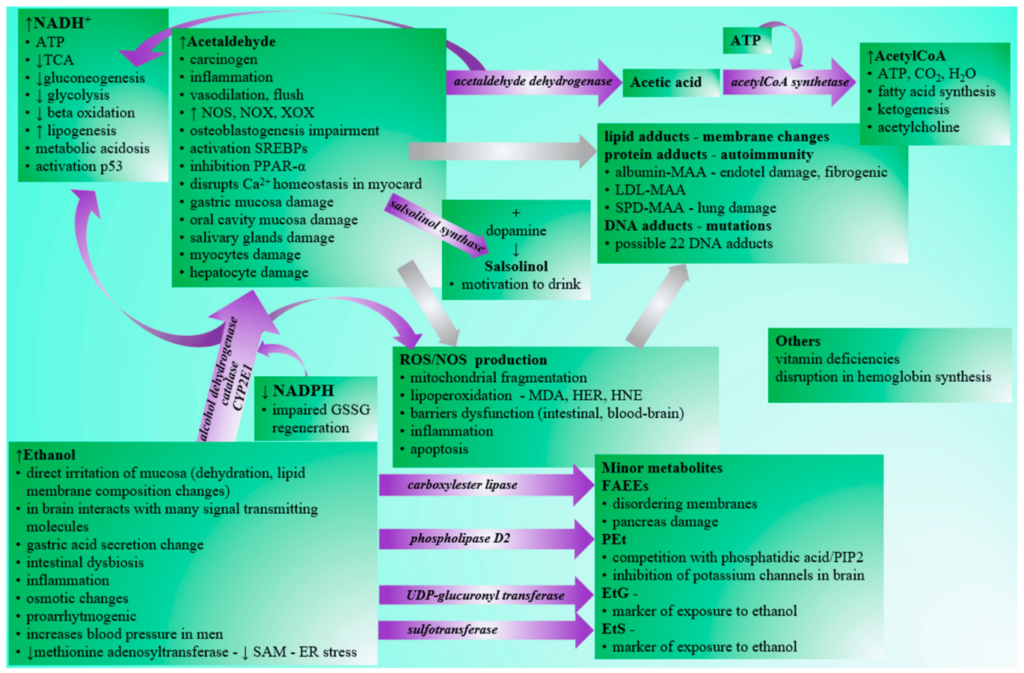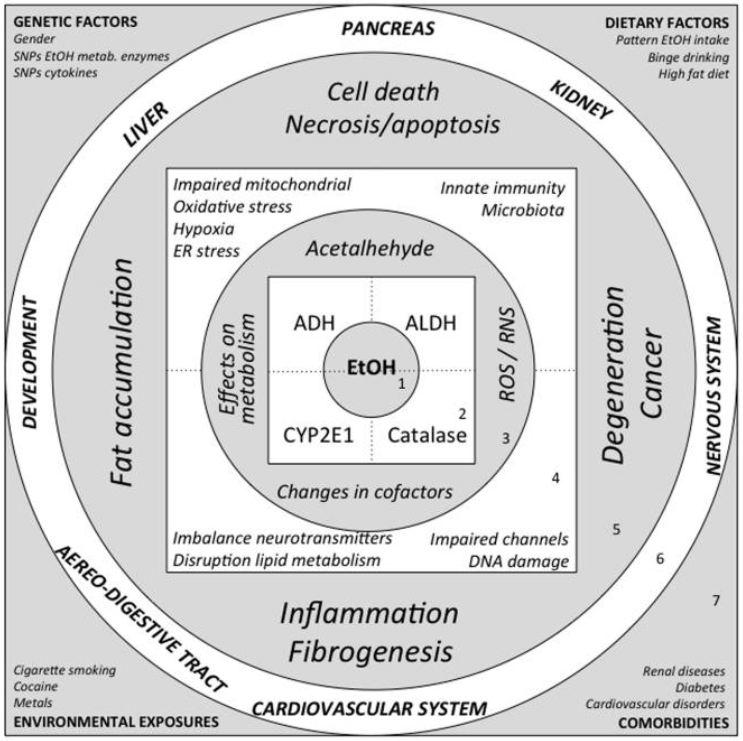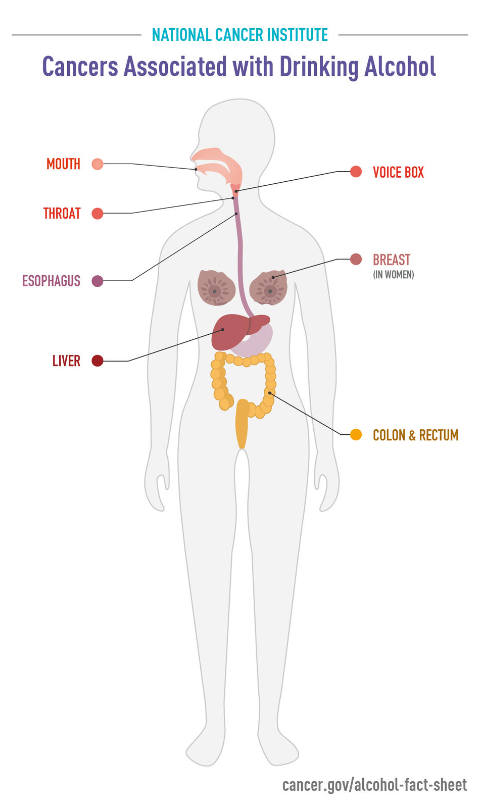Written by Brandon Okey. Mina Draskovic, B.Psy., reviewed this content for accuracy.
Alcohol is a poison, no question about it. It’s a toxic substance that harms your body, no matter how much you drink. The WHO states that “there is no safe amount [of alcohol] that does not affect health.”
A 2021 scientific review further explains that when your body processes alcohol, it creates harmful chemicals that can damage cells, DNA, and proteins and increase the risk of cancer.
We understand the toll alcohol can take on your health. If you’re ready to take control of your life, our alcohol rehab center offers the compassionate, expert care you need to break the cycle and start your journey toward a healthier, alcohol-free life.
Alcohol is toxic because of the way the body metabolizes it. When you consume alcohol, your liver breaks it down into substances the body can eliminate. The first step in this process is converting alcohol (ethanol) into acetaldehyde, a highly toxic and reactive compound. Acetaldehyde is much more harmful than ethanol.
The liver converts acetaldehyde into a less harmful substance called acetate. This compound is eventually broken down into water and carbon dioxide and expelled from the body. If you drink more than your liver can process, acetaldehyde accumulates before having the chance to be converted to acetate, producing its toxic effects.

Alcohol is an organic solvent, which in high doses has both direct and indirect harmful influence on a large number of organs, and a high alcohol intake during a longer period of time implies an increased risk for developing alcohol dependency syndrome. (Grønbæk, Dr Med Sci, PhD)
A 2022 study posits that excessive drinking significantly contributes to the onset and progression of detrimental health conditions. The study also found that alcohol abuse is a massive economic burden.
Alcohol addiction can quickly spiral out of control, damaging your health, relationships, and nearly every aspect of life. With the right support, you can take control and overcome your struggle with drinking.
At our Utah rehab center, we offer comprehensive treatment for alcohol use disorder (AUD), including evidence-based therapies and personalized plans to help you regain control of your life.
“… I received the very latest in medical treatment, along with in-depth counseling and behavioral therapy, that allowed me to begin my recovery in a loving and supportive environment … thanks to Ardu Recovery Center!”
Despite its widespread social acceptance, alcohol’s toxic effects are undeniable. Its consumption triggers a cascade of harmful effects across multiple organ systems, ranging from cellular damage to disruption of vital physiological processes.
Here are eight most harmful effects of alcohol on your body:

Acetaldehyde is highly reactive and can form adducts with proteins, lipids, and DNA. Adducts are chemical compounds formed when acetaldehyde molecules bind to and modify proteins, lipids, or DNA. These modifications disrupt cellular functions and can lead to mutations.
A 2013 study explains that alcohol-induced cellular damage also impairs mitochondrial function and tissue oxygenation. These primary effects trigger a cascade of secondary consequences, which lead to widespread physiological imbalances and tissue damage.
Read more about the detrimental effects of alcohol on your DNA.
Alcohol metabolism generates reactive oxygen species (ROS) and free radicals. These highly reactive molecules damage all vital cellular components. They deplete the body’s antioxidant defenses, further exacerbating oxidative stress.
Alcohol also impairs the function of mitochondria, leading to increased ROS production and reduced ATP synthesis.
A 2001 study found that the microsomal ethanol oxidizing system (MEOS) is an important and detrimental alcohol-metabolizing pathway in the liver. MEOS activity increases with chronic alcohol consumption, generating more reactive oxygen species and depleting cellular antioxidants, which further contributes to oxidative stress.
Alcohol triggers inflammation. Acetaldehyde and free radicals stimulate the release of pro-inflammatory cytokines. Chronic alcohol use leads to systemic low-grade inflammation, characterized by elevated levels of markers such as C-reactive protein and interleukin-6. This contributes to tissue damage and organ dysfunction.
Here’s why alcohol-induced inflammation is bad news:
The pancreas is just one organ that bears the brunt of alcohol’s systemic inflammatory and toxic effects. Do you want to kick the booze and let your organs take a breather? Contact Ardu. We provide a comprehensive range of alcohol recovery programs that help you reclaim your life from addiction.
As the primary site of alcohol metabolism, the liver is particularly vulnerable to alcohol-induced damage. Chronic alcohol consumption can lead to a spectrum of liver diseases, starting with fatty liver (steatosis), progressing to alcoholic hepatitis, and potentially culminating in cirrhosis.
Alcohol’s toxic byproducts trigger inflammation and oxidative stress that cause hepatocyte (liver cell) death. Osna, et. al. suggest that “chronic and excessive alcohol consumption produces a wide spectrum of hepatic lesions, the most characteristic of which are steatosis, hepatitis, and fibrosis/cirrhosis.”
Thankfully, your liver is a miraculous organ with regenerative capabilities. To some extent, liver cells regenerate when you stop drinking.
Alcohol’s neurotoxic effects lead to both acute and chronic brain damage:
Since it also possesses regenerative abilities, your brain may heal and recover with abstinence.
Many people believe that moderate alcohol consumption has cardioprotective effects, so they don’t oppose an occasional glass of wine or beer. This protective potential of alcohol for your heart health is a misconception.
Booze is a toxin that:
Varghese and Darkhode indicate that “alcohol intake leads to both acute (depresses the cardiac function and also alters the blood flow of the involved region) and chronic cardiovascular manifestations.” Another study posits that the inflammatory and oxidative stress effects of alcohol contribute to endothelial dysfunction and atherosclerosis.
So put down that glass of wine. There are healthier ways to support your cardiovascular health.
Alcohol can cause significant damage throughout the gastrointestinal tract (GI):
Alcohol impacts the integrity of the gastrointestinal mucosal barrier. This results in the translocation, via the portal blood flow, of the gut bacteria-derived lipopolysaccharide (endotoxin) and other molecules to the liver and activation of the innate immune response. (Rusyn and Bataller)
Here’s why alcohol is toxic to your entire GI tract:
Alcohol consumption is a known risk factor for several types of cancer. A 2020 global study found that about 4.1% of all new cancer cases worldwide were caused by heavy alcohol consumption.

As a carcinogen, alcohol’s acetaldehyde damages DNA and proteins. It interferes with DNA repair mechanisms and alters hormone levels, particularly estrogen, which can increase breast cancer risk. A 2021 study identified and quantified several acetaldehyde-derived DNA adducts in human oral cells, showing increased DNA damage after alcohol exposure.
Alcohol also acts as a solvent to enhance the absorption of other carcinogens.
Breaking free from alcohol dependence is challenging, but with our specialized alcohol detox program, you can safely deal with withdrawal symptoms and begin your recovery journey. Medically supervised detoxification coupled with personalized holistic therapy and support address both the physical and psychological aspects of alcohol addiction.
Alcohol poisoning is a serious and potentially life-threatening condition that occurs when someone consumes excessive amounts of alcohol in a short period. It is directly linked to the toxicity of alcohol.
At lower levels, your liver can sufficiently process alcohol. When excess alcohol overwhelms the liver, unprocessed toxins accumulate in the bloodstream, manifesting as alcohol poisoning.
Symptoms of alcohol poisoning include:
If you think you may have a drinking problem, Ardu Recovery Center provides professional help and tailored rehab programs to guide you toward lasting recovery. Contact Ardu today.
To understand how much alcohol is toxic for our health, we need to understand how blood alcohol concentration (BAC) works. BAC measures the amount of alcohol in your bloodstream. For example, a BAC of 0.1% means that one-tenth of 1% of your blood is alcohol. A BAC of 0.08% is the legal limit for driving in many countries, but toxic effects can begin at much lower levels.
Alcohol becomes toxic at around a BAC of 0.3% to 0.4%. This amount causes severe central nervous system depression, impairing vital functions such as breathing and heart rate. If you consume about 8 to 10 standard drinks (depending on your body weight and alcohol tolerance) in a short period, you might experience some of the signs of alcohol poisoning.
Even before severe intoxication, alcohol can disrupt your health. Even just two or three alcoholic drinks can cause liver strain and dehydration and contribute to increased overall cancer risk.
Alcohol remains legal despite its toxicity. Cultural acceptance, historical roots, and the powerful influence of the alcohol industry are the reasons for alcohol’s continued legal status.
Societies have long regulated alcohol rather than banning it outright. The 1920s Prohibition led to unintended consequences such as illegal trade and increased crime. Legalization allows governments to regulate production, distribution, and consumption, generate significant tax revenue, and promote public health campaigns.
A 2018 article published in BJPsych Advances indicates that the alcohol industry’s influence often undermines stronger public health policies. Instead, the industry favors less effective methods such as public education and self-regulation.
Despite its legal status, alcohol is still a drug and a poison with virtually no benefits for human health.
Some studies claim that moderate or low amounts of alcohol may offer certain health benefits. These seemingly beneficial effects are only temporary. As a toxin, its risks far outweigh any potential benefits. A 2012 article suggests some of them:
Researchers with the University of Pennsylvania suggest that moderate alcohol intake may reduce stress, enhance mood, and improve certain cognitive functions. Professor Morten Grønbæk with the University of Southern Denmark maintains that “light to moderate alcohol intake is also for many people a natural part of the diet, which increases palatability of and adds calories to the food.”
In the long run, alcohol can devastate mental health as much as physical health. The overall consensus among health experts is that alcohol is inherently dangerous.
Regular consumption, even at lower levels, accumulates toxins, progressively damaging organs and increasing the likelihood of developing chronic health problems and addiction.
“Ardu was the very best place for me to get the help I needed…. They helped me work through my emotions and past trauma…. I’m sober and I’m doing pretty good…. I’m grateful for everyone at Ardu, I owe them my life. I would refer anyone I know to Ardu.”
Ardu offers care and resources you need to overcome addiction and reclaim your life. The first step is to safely navigate detox. We provide medical and holistic detox options, both overseen by experienced professionals committed to your well-being:
Detox is just the beginning. Once you’ve cleared alcohol from your system, the real work of recovery begins. At Ardu, we believe in uncovering the root causes of your addiction through proven psychotherapy methods, equipping you with the tools you need to build a lasting, healthy life.
Recovery looks different for everyone. Our comprehensive treatment plans are designed to meet your unique needs, offering sustainable solutions that support your long-term recovery journey. That’s why we offer a range of treatment options tailored to fit your life:
Many people struggling with alcohol addiction face additional challenges, such as depression, anxiety, PTSD, or other mental health conditions. Our dual diagnosis treatment addresses addiction and any co-occurring mental health issues simultaneously. We want you to receive the comprehensive care necessary for true healing.
Our dual diagnosis services include:
To enroll in an Ardu alcohol rehab program, contact us online or via phone (801-872-8480). We will work with you to find a recovery path that suits your needs throughout the detox process and beyond.

Brandon Okey is the co-founder of Ardu Recovery Center and is dedicated to empowering people on their journey to sobriety.
Alcohol affects the brain by altering neurotransmitter levels, leading to impaired judgment, slow breathing, and reduced coordination. Chronic alcohol misuse can cause permanent brain damage, impacting memory and cognitive functions. Over time, this can contribute to mental disorders and increase the risk of developing substance use disorders. The long-term effects of alcohol on the brain are severe, including an elevated risk of dementia and other neurodegenerative diseases.
One drink a day is considered moderate drinking and may seem harmless, but it still carries risks. Even small amounts of alcohol contribute to long-term health issues such as high blood pressure, heart disease, and an increased risk of certain cancers. The cumulative effects of daily alcohol consumption can lead to a gradual increase in tolerance, making it easier to develop alcohol dependence over time.
Alcohol, specifically ethyl alcohol, has been used for thousands of years for its psychoactive effects, social bonding, and medicinal purposes. Historically, alcohol was a safer alternative to contaminated water. Its widespread use has led to significant public health issues, including alcohol misuse, alcohol poisoning, and chronic diseases such as heart disease and liver failure.
Non-drinkers generally have a lower risk of developing alcohol-related diseases, such as heart disease, liver failure, and certain cancers, which can lead to a longer life. Many people believe that moderate amounts of alcohol may have some protective benefits—which is a misconception—but the overall health risks associated with alcohol often negate these benefits. Non-drinkers avoid the long-term effects and risks of alcohol poisoning, making a sober lifestyle potentially more conducive to longevity.
Alcohol is not needed by the body for any essential function. While ethyl alcohol is a source of calories, it lacks nutritional value and poses significant health risks. The body does not require alcohol, and its ingestion can lead to harmful effects such as slow breathing, impaired judgment, and alcohol poisoning.
Excessive alcohol consumption can result in long-term effects, such as liver disease and heart failure, and increase the risk of developing substance use disorders. Moreover, alcohol can interfere with the absorption of essential nutrients, further harming your health.
Alcohol affects the blood by thinning it, which can increase the risk of bleeding, especially in people with conditions such as ulcers. Chronic alcohol use can also damage the liver, leading to issues with blood clotting. Alcohol consumption can elevate blood pressure, increasing the risk of heart disease and stroke. In cases of alcohol poisoning, the blood alcohol content can rise to dangerous levels, leading to slow breathing, unconsciousness, and even death.
Surviving solely on alcohol is impossible. Alcohol lacks essential nutrients and causes severe health consequences. When consumed in excess, alcohol leads to dehydration, malnutrition, and impaired organ function. Alcohol’s diuretic effect exacerbates dehydration, so reliance on alcohol will produce the effects of alcohol poisoning, including slow breathing and unconsciousness. The lack of vitamins, minerals, and hydration from non-alcoholic sources would quickly lead to organ failure and death.
Consuming 20 beers a day is extremely excessive and poses serious health risks. Such a high level of alcohol intake significantly raises blood alcohol levels, leading to alcohol poisoning, liver damage, and long-term effects. Drinking alcohol at this level can overwhelm your body’s ability to metabolize alcohol, resulting in severe symptoms such as slow breathing, unconsciousness, and an increased risk of alcohol poisoning deaths.
Consuming 6 beers a day is considered heavy drinking and can lead to liver damage over time. The liver metabolizes alcohol, but excessive amounts overwhelm this process, causing fatty liver, hepatitis, and eventually cirrhosis. Continuous heavy ingestion of alcohol increases the risk of severe alcohol poisoning and can result in long-term effects such as heart disease and liver failure. This level of alcohol intake also heightens the risk of developing alcohol use disorders.
Birková, A., Hubková, B., Čižmárová, B., & Bolerázska, B. (2020). Current View on the Mechanisms of Alcohol-Mediated Toxicity. International Journal of Molecular Sciences, 22(18), 9686. https://doi.org/10.3390/ijms22189686
Grønbæk, M. (2009). The positive and negative health effects of alcohol- and the public health implications. Journal of Internal Medicine, 265(4), 407-420. https://doi.org/10.1111/j.1365-2796.2009.02082.x
Varghese, J., & Dakhode, S. (2022). Effects of Alcohol Consumption on Various Systems of the Human Body: A Systematic Review. Cureus, 14(10). https://doi.org/10.7759/cureus.30057
Rusyn, I., & Bataller, R. (2013). ALCOHOL AND TOXICITY. Journal of Hepatology, 59(2), 387. https://doi.org/10.1016/j.jhep.2013.01.035
Zima, T., Fialová, L., Mestek, O., Janebová, M., Crkovská, J., Malbohan, I., Štípek, S., Mikulíková, L., & Popov, P. (2001). Oxidative stress, metabolism of ethanol and alcohol-related diseases. Journal of Biomedical Science, 8(1), 59–70. https://doi.org/10.1007/bf02255972
Osna, N. A., & Kharbanda, K. K. (2017). Alcoholic Liver Disease: Pathogenesis and Current Management. Alcohol Research : Current Reviews, 38(2), 147-161. https://www.ncbi.nlm.nih.gov/pmc/articles/PMC5513682/
Daviet, R., Aydogan, G., Jagannathan, K., Spilka, N., Koellinger, P. D., Kranzler, H. R., Nave, G., & Wetherill, R. R. (2022). Associations between alcohol consumption and gray and white matter volumes in the UK Biobank. Nature Communications, 13(1), 1-11. https://doi.org/10.1038/s41467-022-28735-5
Higashi, Y. (2022). Roles of Oxidative Stress and Inflammation in Vascular Endothelial Dysfunction-Related Disease. Antioxidants, 11(10). https://doi.org/10.3390/antiox11101958
Rumgay H, Shield K, Charvat H, Ferrari P, Sornpaisarn B, Obot I, Islami F, Lemmens VEPP, Rehm J, Soerjomataram I. Global burden of cancer in 2020 attributable to alcohol consumption: a population-based study. Lancet Oncol. 2021 Aug;22(8):1071-1080. doi: 10.1016/S1470-2045(21)00279-5. PMID: 34270924; PMCID: PMC8324483.
Guidolin, V., Carlson, E. S., Carrà, A., Villalta, P. W., Maertens, L. A., Hecht, S. S., & Balbo, S. (2021). Identification of New Markers of Alcohol-Derived DNA Damage in Humans. Biomolecules, 11(3). https://doi.org/10.3390/biom11030366
Luty, J. (2016). Alcohol policy and public health. BJPsych Advances, 22(6), 402–411. https://doi.org/10.1192/apt.bp.115.015081
Baum-Baicker, C. (1985). The psychological benefits of moderate alcohol consumption: A review of the literature. Drug and Alcohol Dependence, 15(4), 305-322. https://doi.org/10.1016/0376-8716(85)90008-0
How long does alcohol detox last?
What is alcohol withdrawal syndrome?